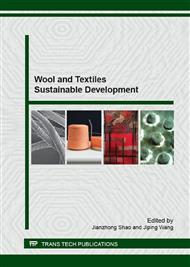p.88
p.95
p.103
p.109
p.115
p.121
p.133
p.139
p.149
Natural Compounds from Plant Waste for Textile Processing: Construction and Evaluation of Dyeing and Finishing with Extracting Solution of Tea-Stalk and Apocynum Halm
Abstract:
Nature provides readyanswers to scientific and technical problems and inspires us with a series of technologicalinnovations. The distribution of pigment in vivo inspired theprocess of fabric finishing. Naturalcompounds from plant waste was employed for textile processing in thisinvestigation and the method of dyeing and finishing simultaneous wasconstructed. Capacity and function of the process was evaluated through colour yield and fastness, antifungalactivity and UV –protection performance. Tawny colour was obtained in theprotein fabrics processed with the extracting solution of tea-stalk and Apocynum halm. The fastness properties of both tea and Apocynum dyed samplesare quite satisfactory for practical textile dyeing purposes, especially thewool fabrics processed with tea-stalk extracting solution. And the protein fabric samples treated with tea and Apocynum waste solutionshowed good inhibitory effect (>50%) against E.coli and S.aureus. UV protection level ofprotein fabrics were increased with the treatment by extracting solution of tea-stalkand Apocynum halm.
Info:
Periodical:
Pages:
115-120
Citation:
Online since:
November 2015
Authors:
Price:
Сopyright:
© 2016 Trans Tech Publications Ltd. All Rights Reserved
Share:
Citation:


